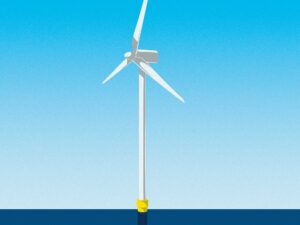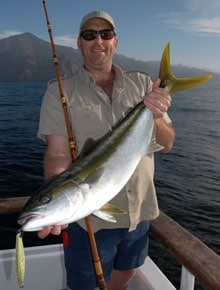
It’s difficult to describe the split-second, adrenaline-triggered rush when a spool abruptly stops revolving and you suddenly can’t turn the reel handle any more. Reason: something on the other end of your line has mistaken a molded piece of metal for an easy meal, and now the creature is not at all pleased with its menu choice. Part of the angler’s excitement may be that lure fishing is the epitome of trickery fooling a fish into striking a fraud, especially when other anglers are using natural baits.
While soft-plastic lures have grown in popularity among Pacific Coast yellowtail anglers over the past two decades, there are still many who prefer slinging the tried-and-true hard-iron lures, or jigs, for their fishing. (Pacific Coast salt water anglers often use the terms “lures” and “jigs” generically and interchangeably.) For those loyalists who cast and retrieve the so-called hard-iron, candy-bar-shaped artificials, here are ten tips on catching yellowtail.
Tie Leader Directly to Ring of the Iron
It is tempting, especially for beginners, to use a snap or snap-swivel to connect the fishing line to the lure. The good news is that snaps make lure changes quick and easy. The bad news is that either a snap or snap-swivel will rob the lure of its intended action. An iron is designed to swim properly only when its forward ring is tied directly to the line. Snaps can make a lure act sluggish and unattractive. Use a palomar, a doubled improved clinch or a San Diego jam knot to attach the lure.
Use A Count Down to Control the Depth of Your Fishing Iron
Once the depth range is found at which most yellowtail are being hooked, you need to control the sink rate of the lure so it reaches the same approximate depth on each successive drop. To do this, use the count-down method: once the lure is dropped, start a mental count of 1-2-3-4 and so on, until the lure reaches the corresponding number representing the depth you want. It may help to first test the descent speed of the lure by watching it sink next to the boat. If it sinks about a foot per second, then a count from one to 30 will place it about 30 feet below the surface. Remember, the longer the cast, the slower the lure will sink, since long heaves create more line laying across the water, thereby increasing the drag on the line and sinking lure. Be alert for strikes on the drop as well. If one occurs, immediately wind the line taut to set the hook.
Find a Fishing Technique That Works and Replicate It
Whether you’re fishing with a couple of buddies on a small private boat or angling among dozens aboard a party boat, think of the other anglers as scouts who are testing the waters for you. See who’s hooking up most frequently—especially when the same successful ones begin to distance themselves from the group—and note how far he’s casting, how deep he’s fishing, his retrieve speed and the type, color and pattern of his lure.
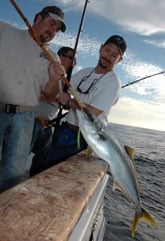
What to Do When Yellowtail Are Holding on the Bottom
When yellowtail are holding close to the bottom, let your lure sink until slack line indicates that it has bottomed out, then put the reel in gear and perform three lifts and drops of the rod tip. Raise the tip sharply from an eight-o’clock position to ten o’clock, giving the lure an upward “spurt” of movement, then lower the rod quickly so the lure sinks. The line should be just slack enough to let the lure flutter on a free fall.
This sweep-up-and-flutter-down motion simulates an injured baitfish or an escaping squid and can stir a strike on either the rise or fall of the lure. If no strike occurs after three sweeps, start a steady, fast, vertical retrieve. Since the sweep-and-fall is done just a couple of reel-handle turns off the bottom, grouper or giant sea bass (off Baja), white seabass, rockfish and even large halibut are sometimes hooked too.
Use Lightweight Surface Irons for Yellowtail on Top
Remember to go lighter and slower when fishing for yellowtail feeding on or near the surface. Hard-iron lures used for bottom jigging or yo-yoing (vertical retrieving from the bottom) are made of zinc and designed to sink fast and stay in a near-vertical plane on a rapid retrieve. Surface irons, however, are made of lighter aluminum, and are designed to swim enticingly at slower retrieve speeds.
In the hands of an experienced lure angler, the lighter, slower surface models out-fish and, more importantly, out-catch their deep-water counterparts. Slow your retrieve down to a moderate speed when surface fishing the lighter-model jigs.
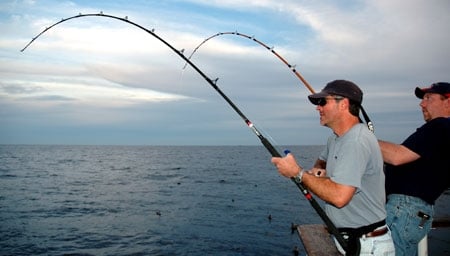
Wind Tight After the Bite — Don’t Set the Hook
For years, we’ve been taught to raise the rod tip sharply to set the hook the instant a fish strikes. Today’s methodology has changed that thinking. We’ve learned that fewer fish are lost when we simply keep winding after a lure strike. “Wind, wind, wind” is the cry of the crews these days. Reel rapidly to take all of the slack out of the line and wind the fish on the spool.
Use Fluorocarbon Leader When the Bite is Tough
More anglers are trying fluorocarbon leaders when fishing is tough. Some days, a 36- to 40-inch length of the barely visible material is enough to reduce a yellowtail’s wariness and increase your strikes. Either join fluorocarbon to the main mono line (the latter is usually 40- or 50-pound test) with a blood knot or a small steel ring as a connector between the leader and main line.
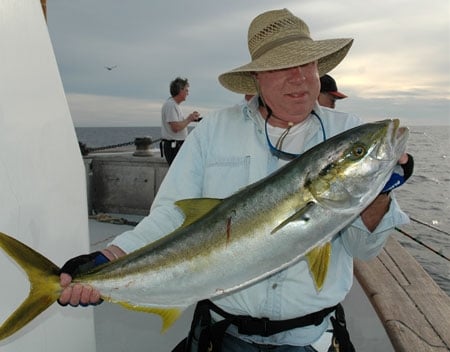
Find the Fish in the Water Column
When using a straight, vertical, yo-yo-style retrieve, wind the lure only through the fish-holding zone, which can vary significantly from the total water column. If you are fishing in 150 feet of water, for instance, it may be that the fish are holding close to the bottom and the majority are being hooked in only the last 50 feet of depth.
Birds Can Help Lead You to a Fish Feeding Frenzy
Understanding the signs of bird behavior, boils and breezers (ripples which resemble the surface effects of a breeze) improves your catch rate. Birds that dive or hover may be feeding on baitfish driven to the surface by feeding yellows. Likewise, rafting birds can indicate that a blitz has just ended, or one is anticipated. Birds don’t just hover or raft in a particular spot at random.
You can often tell which direction feeding yellows are traveling by the direction of movement of the flying birds, boils or breezers. Cast slightly beyond and ahead of the surface disturbances so, on the retrieve, you can crank your lure across the leading edge of the feeding fish.
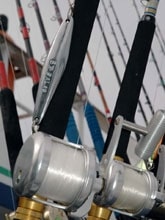
Use High-Speed Tackle for Yellowtail
Since heavier and larger lures require a fast retrieve, tackle usually includes a high-speed reel. Years ago, that meant a basic, 4:1 gear ratio. Now, the benchmark ratio hovers around 5:1, with 5.5:1 or even 6:1 retrieve ratios good choices for some fishing conditions. The reel should hold at least 250 yards of 50-pound-test mono.
Rods can range from 9-foot, parabolic-action, long-distance, surface-casting jig sticks to short, 5- to six-foot, fast-taper, stroker-action rods for deep-water yo-yo retrieving when casting isn’t necessary.
A good assortment of lures in both lighter surface models and heavier yo-yo models is a must. Although about a half dozen, hard-iron lure brands are made in Southern California, the most well-known are Salas Aluminum Lures and Tady Lures. Proven hard-iron lure patterns include blue-and-white, green-and-yellow, blue-mackerel, green-mackerel, chrome-and-blue, all-chrome, scrambled egg, blue-mackerel-and-chrome, green-mackerel-and-chrome and sardine.

